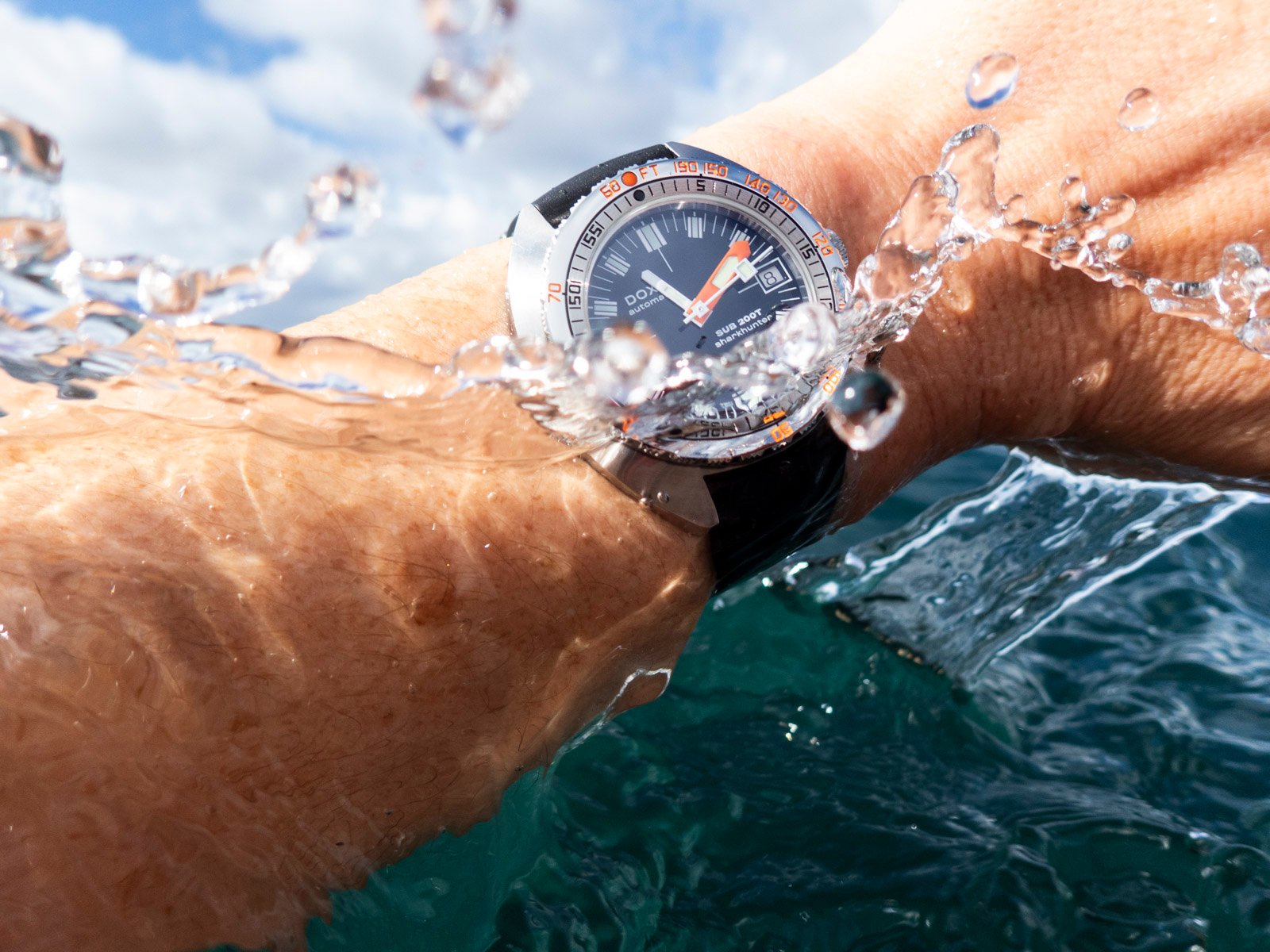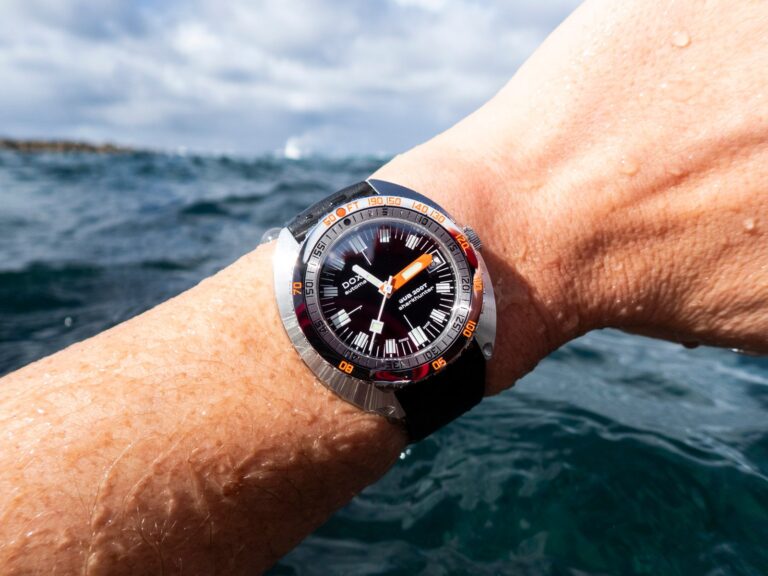Doxa’s Sub 200T is the perfect watch for underwater use, highlighting the trend towards small tool watches. Debuting just before the start of Watches and Wonders 2024, the Sub 200T was met with widely positive reviews. With a case diameter of 39mm and a slim profile, it’s a very mid-sized option that rounds out Doxa’s cushion-case range very nicely.
Doxa dive watches have always been comfortable due to their short lug-to-lug length, a little design tweak that allows the larger watch to fit a variety of wrist sizes. As a regular Sub 300 owner, I can attest to this: with a lug-to-lug length of 45mm, the 42mm case fits perfectly on a 16cm wrist.
The Doxa Sub 200T fills a gap in the brand’s collection
Still, for a tradition-focused watch brand like Doxa, there has been a lack of a mid-sized offering, something my colleague Thomas points out. The Sub 300T has a classic look but with enhanced features like a helium release valve, making it very similar to the vintage Doxa Sub 300T Conquistador, a beefed-up version of the original Sub 300.
Doxa’s Sub 300, on the other hand, is a watch for vintage enthusiasts: its smaller dial and slim case profile make it a very appealing package for anyone interested in the original vintage version that debuted in 1967. Firmly entrenched as a cornerstone of the brand, the Sub 300 is equipped with a COSC-certified movement.

Image: Dr Peter Miller
The ancestor of the Doxa Sub 200T
So while Doxa had the sturdy Sub 300T and the more elegant 300, they still didn’t have a sub-40mm Sub. If there was ever a time to introduce a smaller version, now seemed like the right time. Yes, small tool watches are all the rage. This was definitely a contributing factor. Anyone interested in this trend towards smaller tool watches need only look to Tudor’s 37mm Black Bay 54 as one of the trendsetters, although the pattern was around before the 54 (the Black Bay 58 and the return of the Rolex 36mm Explorer, to name just a few).
But Doxa’s new Sub 200T isn’t an entirely new concept. A smaller Sub series existed during the brand’s golden age in the 1960s and ’70s. What remains are essentially Sub 300Ts scaled down to 35mm size. These were also called Sub 200s. Doxa promoted these as women’s watches. You can see them in old Doxa advertisements. These were small mechanical watches that retailed a bit higher than the full-sized watches.


Doxa expert Dr. Peter Miller’s website is packed with the brand’s history and features photos of several examples, including a black-dial Sea Maid, an orange-dial Coralyne, and a silver-dial Nymph. So Doxa’s decision to re-release the old Sub 200 in a 39mm “T” shape was something of a return to form.

A modern watch with a modern touch
Let’s go back to the Doxa Sub 200T, which was released earlier this year. It comes with a screw-down crown, the iconic unadorned bezel, and a 200m water-resistant case with plenty of color options. We won’t go into too much detail about the specs here (we’ve covered them in detail before on Fratello), but it’s worth noting that these watches have a slim 10.7mm thickness and a lug-to-lug length of 41.5mm. These dimensions have the biggest impact on how the watch fits and wears.
For example, it’s no wonder so many people appreciate the form factor and ergonomics of neo-vintage Omegas. Looking at the Nacho ref. 2254.50 (12mm thick), it’s a relatively thin model with some appealing features. This is largely due to its use of a modified ETA 2892 caliber, a slimmer movement.

Doxa quietly updated the bracelet
Those familiar with Doxa’s latest models will be familiar with the following complaints about the bracelet: The Beads of Rice metal bracelet on the Doxa Sub 300 and 300T is comfortable to wear, but it does have a few issues: Starting with the Sub 300, the clasp is truly vintage-inspired, with what appears to be stamped metal and a few holes for fine adjustments – a clasp from the 1960s that just doesn’t seem right.
The Doxa Sub 300T, on the other hand, has a much better clasp with a modern diver’s extension. However, the bracelet is wider where it meets the case and the end links don’t have much movement, meaning it’s harder to wear if you have a smaller wrist. Thankfully, Doxa’s new Sub 200T solves both of these issues. The clasp is similar to that of the Sub 300T, and the end links are fully movable, so they fit under the case. This is a big plus for those who plan on using a beads-of-lyce bracelet.

Add a touch of sparkle
I was planning on taking these Doxa Sub 200Ts with me across the Pacific Ocean. As soon as I took them out of the box I noticed how striking the new Sunray finish was in the Professional colorway. You can see the difference between the Matte and Sunray finishes in the images below.
One thing I also wanted to highlight was just how compact these Doxa Sub 200Ts are compared to their vintage predecessors. In the two images above, I’ve paired a black Sharkhunter and a silver Searambler with an original Sub 300 from the late 1960s. As you can see, these watches are very compact. But another thing you’ll notice is how similar the dial apertures are.

Wetting the Doxa Sub 200T
The weather has been rough here in Australia, with regular storms and endless rain lashing the country’s east coast. This made shooting with the Doxa Sub 200T in its natural underwater environment a challenge. I wanted to see how this design compared to its larger sibling underwater, focusing on three main points: ergonomics, comfort and legibility.
As anyone who regularly wears a watch in saltwater will agree, all three of these factors change underwater. The frictional effects of the ocean can make a watch that is comfortable on land difficult to wear underwater. A watch that may be ergonomic above water can feel heavy or unwieldy beneath the waves. Similarly, a watch that is legible above sea level can become extremely difficult to read below the surface, even at a depth of just a few meters.

Ergonomics, comfort and legibility
Let’s start with ergonomics. For comparison, I also had the Doxa Sub 300T and Sub 300. The first thing I noticed was how thin the Sub 200T is. The relatively thin bezel and case (unlike the Sub 300T) combined with the flat crystal (unlike the spherical crystal on the Sub 300) makes for a great ergonomic experience in the water. When I jumped in the ocean and navigated choppy waters, I had no fear of smashing the Doxa on a rock. This is in contrast to its thicker, chunkier big brother, the Sub 200T.
The factors mentioned above also greatly aided comfort. The compact lugs and thin case gave the impression of it melting into the wrist. In terms of legibility, I found the Doxa Sub 200T to be not much worse than the Sub 300T. I even found it easier to read than the Sub 300 at a glance, thanks to the flat crystal. Overall, the Doxa Sub 200T is (for me) better than its bigger brother in all three categories.

lastly
Doxa has created a hit product. Just today my partner was raving about the orange Doxa Sub 200T Professional. Perhaps the best thing about this new product is that Doxa has entered a truly new market and created a product that is more approachable for both men and women. To me, this seems like a great way to gain new fans.
But what do you guys think? Would you wear one of the Doxa Sub 200T models, or would you prefer the larger Sub 300 or Sub 300T? Let us know in the comments.
